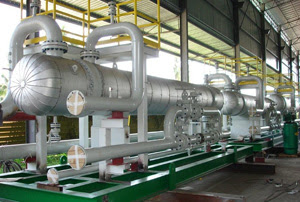Natural gas that people use in their homes is different from recently extracted natural gas. Before people can use it for cooking and heating, it has to be processed first. The first step is the removal of oil and condensates.
 |
| Image Source: en.wikipedia.org |
There are different processes and equipment used to separate oil (or condensates) from natural gas. In addition, raw natural gas from different regions can have different compositions and separation requirements. This is why in some cases the separation of oil and gas is only a simple matter, requiring only a conventional separator, which uses gravity to separate natural gas from heavier liquids like oil and hydrocarbon compensates, while sometimes it may require specialized equipment, such as the Low-Temperature Separator (LTX).
 |
| Image Source: fraseruniquip.com |
The LTX utilizes pressure to lower the temperature of the wet natural gas and separate the oil and condensates. Its temperature lowered by a heat exchanger, the wet natural gas enters the separator and flows through a high-pressure liquid knockout and into a low-temperature separator via a choke mechanism that expands the gas as soon as it enters. After the liquid is removed, the now dry gas then flows back through the heat exchanger and is heated up by the incoming wet gas. These temperature changes cause oil, condensates, and water to be separated from the wet gas stream.
.jpg) |
| Image Source: pulsamerica.co.uk |
Natural gas processing is a complicated process, but there are some excellent books out there that have a wealth of information about it, such as Arthur J. Kidnay Fundamentals of Natural Gas Processing and Dr. Ali Ghalambor and Boyun Guo’s Natural Gas Engineering Handbook.
Learn more about natural gas processing by following this Twitter page.
No comments:
Post a Comment